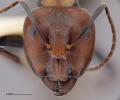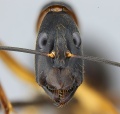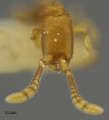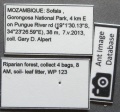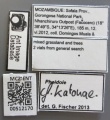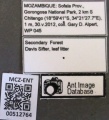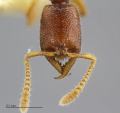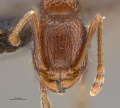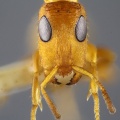Ant Diversity of Gorongosa National Park, Mozambique

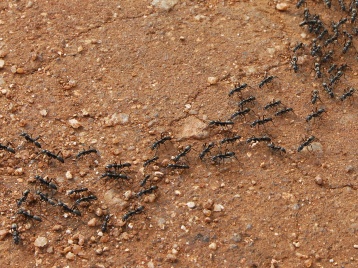
Gorongosa National Park [1] in Mozambique is in the process of restoring animals to this wonderful habitat and is creating a biodiversity inventory of the fauna and flora within the park boundary. The ants are being inventoried as a special project.
This page supports the study of the ant diversity of Gorongosa National Park, Mozambique. Even though the richness of the ant fauna has not been fully examined, so far we have posted records of 52 genera and 209 species. This page will include notes on biology and distribution. Illustrated keys to species will be presented using a combination of identification tools.
Contributors
- E.O. Wilson (Harvard University)
- Gary D. Alpert (Harvard University)
- Piotr Naskrecki (Harvard University\Gorongosa National Park)
- Patrick McCormack (Harvard University)
- Leeanne Alonso (Global Wildlife Conservation)
- Allan Short (Gorongosa National Park)
- Marc Stalmans (Gorongosa National Park)
- Vasco Galante (Gorongosa National Park)
- Kathleen Horton (Harvard University)
- Domingos Muala (Gorongosa National Park)
- Tonga Torcida (Gorongosa National Park)
- Francisco (Paco) Hita-Garcia (Hessisches Landesmuseum, Darmstadt, Germany)
Acropyga
- Acropyga species (arnoldi)
Anochetus
- Anochetus species 1 (talpa)
- Anochetus species 2 (katonae)
Anoplolepis
Atopomyrmex
Bothroponera
- Bothroponera cariosa Emery, 1895
- Bothroponera kruegeri Forel, 1910
- Bothroponera cf. pachyderma
- Bothroponera species 2 (crassa)
- Bothroponera species 7 (silvestrii)
- Bothroponera species 8 (soror)
Calyptomyrmex
- Calyptomyrmex kaurus Bolton, 1981
- Calyptomyrmex species 1 (piripilis)
Camponotus
- Camponotus auropubens Forel, 1894
- Camponotus braunsi Mayr, 1895
- Camponotus chrysurus Gerstäcker, 1871
- Camponotus cosmicus (Smith, 1858)
- Camponotus grandidieri Forel, 1886
Worker
Queen
- Camponotus robecchii troglodytes Forel, 1894
- Camponotus valdeziae Forel, 1879
This species nests in the ground in open areas. There is a modest crater surrounding the nest opening. Workers are polymorphic. They are very fast moving ants active during the day
- Camponotus vestitus (Smith, F., 1858)
- Camponotus species 1
- Camponotus species 5
- Camponotus species 6
- Camponotus species 8
- Camponotus species 12
- Camponotus species 15
- Camponotus species 16
- Camponotus species 19
- Camponotus species 20
Cardiocondyla
Carebara
- Carebara species 1
- Carebara species 2 (perpusilla)
- Carebara species 3 (arnoldiella)
- Carebara species 4
- Carebara species 5 (erythraea)
- Carebara species 6 (sarita)
- Carebara species 7 (nicotianae)
- Carebara species 8
Cataulacus
- Cataulacus species 1 (brevisetosus)
- Cataulacus species 5
Centromyrmex
- Centromyrmex sellaris Mayr, 1896
Cerapachys
- Cerapachys species 1 (Parasyscia sudanensis)
- Cerapachys species 2 (Parasyscia)
- Cerapachys species 3 near wroughtoni (Eburopone)
- Cerapachys species 4
Crematogaster
- Crematogaster species 1
- Crematogaster species 2
- Crematogaster species 3
- Crematogaster species 4
- Crematogaster species 5
- Crematogaster species 6
- Crematogaster species 7
- Crematogaster species 8
- Crematogaster species 9
Discothyrea
- Discothyrea traegaordhi Santschi, 1914
Dorylus
See Key to Dorylus species of Gorongosa National Park
- Dorylus species 1 (helvolus)
- Dorylus species 2/5/6 (fulvus)
- Dorylus species 3 (helvolus)
- Dorylus species 4/7 (nigricans molestus)
- Dorylus species 5/6/2 (fulvus)
- Dorylus species 6/5/2 (fulvus)
- Dorylus species 7/4 (nigricans molestus)
Hypoponera
- Hypoponera spei Forel, 1910
- Hypoponera species 1 (angustata)
- Hypoponera dulcis (Forel, 1907)
- Hypoponera species 3 (importuna)
- Hypoponera species 4 (ragusai)
Lepisiota
- Lepisiota species 1
- Lepisiota species 2
- Lepisiota species 3
- Lepisiota species 4
- Lepisiota species 5
Leptogenys
- Leptogenys species 1 (janneli)
- Leptogenys species 3 (nitida)
- Leptogenys species 5 (ferrari)
Megaponera
- Megaponera analis (Megaponera analis)
- Megaponera species 9
- Megaponera species 4
Melissotarsus
- Melissotarsus emeryi Forel, 1907
Only a single species of Melissotarsus has been found in Mozambique. This species was found in a small secondary forest patch a few kilometers east of Chitengo. This species can be identified by the abrupt anterior edge of the pronotum in dorsal and lateral view. Many workers and several queens nest under the bark of a a tree tunneling their galleries in live wood, close to the surface. They tend armoured scale insects and only depart from their nest for mating flights.
Reference:
Meranoplus
Mesoponera
- Mesoponera ambigua Andre, 1890
- Mesoponera subiridescens Wheeler, W.M. 1922
- Mesoponera species 11 (ingesta)
Microdaceton
Monomorium
- Monomorium species 1
- Monomorium species 4
- Monomorium bicolor species 5 (bicolor)
- Monomorium invidium species 6 (invidium)
- Monomorium hanneli species 7
- Monomorium species 8
- Monomorium species 10
- Monomorium shilohense species 11
Myrmicaria
- Myrmicaria species 1
- Myrmicaria species 2
Nesomyrmex
Nylanderia
Ocymyrmex
Odontomachus
This species has been found on Gorongosa Mountain within the park at about 800 meters elevation.
This species has been found frequently at lower elevations surrounding Chitengo Camp in moist forest that is occasionally inundated during the rainy season. Nests are often located under and in rotten wood on the ground.
Key to Odontomachus species
Return to List of ant species of Mozambique.
- In dorsal view, pronotm with transverse rugae, gaster without appressed hairs , (Fig. 1) Odontomachus assiniensis
- In dorsal view, pronotom with longitudinal rugae, gaster with numerous short appressed hairs , (Fig. 2) Odontomachus troglodytes
 Fig.1. Dorsal view of Odontomachus assiniensis worker |
 Fig.2. Dorsal view of Odontomachus troglodytes worker |
Oecophylla
Paltothyreus
- Paltothyreus tarsatus (Fabricius, 1798)
- Paltothyreus species 10
Paraparatrechina
Paratrechina
Petalomyrmex
Pheidole
- Pheidole species 1 cf. kitschneri
- Pheidole cf. aurivillii
- Pheidole cf. caffra
- Pheidole cf. katonae
- Pheidole cf. megacephala
- Pheidole cf. njassae
- Pheidole cf. tenuinodis (mentita)
- Pheidole species 8 (strator fugax)
- Pheidole species 9 (crassinoda pluto)
- Pheidole species 10 (arnoldi ballaensis)
- Pheidole species 11 (strator fugax)
Plagiolepis
- Plagiolepis chirindensis Arnold, 1949
- Plagiolepis species 2 (fuscula)
- Plagiolepis species 4 (brunni)
- Plagiolepis species 5
Platythyrea
Plectroctena
This species is a specialized predator of millipedes.
Key to Plectroctena species
Return to List of ant species of Mozambique.
- In frontal view, ventral surfaces of head with striation between the punctures, color black (Fig. 1) Plectroctena mandibularis
- In frontal view, ventral surfaces of head without striation between the punctures, color red or orange-brown (Fig. 2) Plectroctena subterranea
 Fig.1. Dorsal view of Plectroctena mandibularis worker |
 Fig.2. Dorsal view of Plectroctena subterranea worker |
Polyrhachis
- Polyrhachis species 1
- Polyrhachis species 2 (gagates)
- Polyrhachis species 4 (schlueteri)
- Polyrhachis species 5 (viscosa)
Pristomyrmex
- Pristomyrmex cribrarius Arnold, 1926
Proceratium
Pseudoponera
- Pseudoponera species 6 (Mesoponera)
Solenopsis
- Solenopsis species 1
- Solenopsis species 2
- Solenopsis punctaticeps Mayr 1865
Sphinctomyrmex
- Sphinctomyrmex species 1 (Zasphinctus)
Stigmatomma
- Stigmatomma species 1
Strumigenys
These slow moving ants specialize on collembola found in leaf litter. This species appears to be rather common throughout Gorongosa National Park.
- Strumigenys lujae Forel, 1902
- Strumigenys maxillaris Baroni Urbani, 2007
- Strumigenys species 2
Syllophopsis
Tapinolepis
- Tapinolepis species 1
Tapinoma
- Tapinoma species 1 (luteum)
Technomyrmex
- Technomyrmex ilgi (Forel, 1910)
- Technomyrmex FHG sp1
- Technomyrmex FHG sp2
Tetramorium
- Tetramorium decem (ultor)
- Tetramorium do Forel, 1914
- Tetramorium gladstonei Forel, 1913
- Tetramorium humbloti Forel, 1891
- Tetramorium longicorne Forel, 1907
- Tetramorium muscorum Arnold, 1926
- Tetramorium phasias Forel, 1914
- Tetramorium sepositum Santschi, 1918
- Tetramorium sepultum Bolton, 1980
- Tetramorium sericeiventre Emery, 1877
- Tetramorium setigerum Mayr, 1901
- Tetramorium setuliferum Emery, 1895
- Tetramorium simillimum (Smith, F., 1851)
- Tetramorium weitzeckeri Emery, 1895
- Tetramorium zambezium Santschi, 1939
- Tetramorium species 1 (gabousense group sp. n.)
- Tetramorium species 2 (camerunense group sp. n.)
- Tetramorium species 3
- Tetramorium species 7 (solidum group sp. n.)
- Tetramorium species 13 (pusillum)
Tetraponera
- Tetraponera ambigua (Emery, 1895)
- Tetraponera emeryi Forel, 1911
- Tetraponera natalensis Smith, F. 1858
- Tetraponera schulthessi Santschi, 1915












































































































